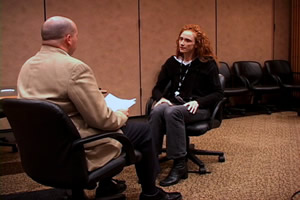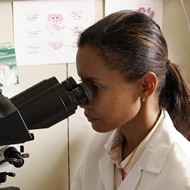
Environmental Factor, November 2008, National Institute of Environmental Health Sciences
Working with the Media to Communicate Science
By Robin Mackar
November 2008

The NIEHS Office of Communications and Public Liaison (OCPL) recognizes the important role that the media can play in helping NIEHS communicate its research to the American public. For this reason, much of late September and October was dedicated to media training and media outreach efforts.
On September 29 - 30, fifteen scientists from various divisions of the Institute, including NTP, DERT and DIR participated in one of three half-day personalized media training sessions. The sessions were held on the main campus of the NIEHS facility and were led by two communication coaches from The Communication Center, a Washington, D.C.-based company known for its expertise in training NIH scientists.
“We really work to tailor the media training to meet the needs of our busy scientists,” said Christine Flowers, OCPL Director. The training supported by OCPL and NTP included an overview on message development, tips on communicating complex information so it is clear, concise and quotable, delivery skills and providing scientists the confidence they need to maintain control of a media interview. Each participant was provided an on-camera opportunity to answer questions about their area of expertise.
Given that the majority of the NIEHS interview requests are phone interviews with print reporters, the training focused heavily on preparing scientists for print interviews. Each of the three sessions included an individual who participated in a pre-interview by phone with a reporter from The Communication Center. A newspaper article was developed based on each interview and brought to the training session. Participants read the stories and then a debriefing occurred, with the individual print reporter participating via telephone, giving the participants an opportunity to find out why specific quotes, headlines and details were selected for the story.
Flowers said she was pleased with comments by participants. NTP scientist Kristina Thayer, Ph.D., for example, described the media training as “very instructive and useful,” and colleague Michelle Hooth, Ph.D., said, “I learned some good practical tips.”
“This was the one training session where I actually came away with the feeling that I was given really good practical information,” wrote one participant on the training evaluation form — giving Flowers and her staff added incentive to work toward providing additional training opportunities in the future to help scientists communicate their findings more effectively.
Annual Conference
In mid-October, Flowers and OCPL News Director Robin Mackar headed to Roanoke, Va. to communicate with journalists themselves. There they participated in the 18th Annual Conference of the Society of Environmental Journalists (http://sej.org/) ![]() , which was attended by more than 800 reporters. The OCPL staffers met with many of the reporters, disseminated information, and supported the efforts of Gwenn Collman, Ph.D., and Jerry Heindel, Ph.D., of DERT as they participated in several events.
, which was attended by more than 800 reporters. The OCPL staffers met with many of the reporters, disseminated information, and supported the efforts of Gwenn Collman, Ph.D., and Jerry Heindel, Ph.D., of DERT as they participated in several events.
Collman served on a panel titled “Does Environment Trump Genetics? Teasing out the Factors Affecting Women’s Health.” Collman also participated in a “beat” dinner with about a dozen reporters where she highlighted the NIEHS Partnerships for Environmental Public Health (PEPH) program.
Heindel participated in a panel moderated by a reporter from the Milwaukee Journal Sentinel that focused on endocrine disruptors and toxicology. Heindel also talked to reporters during a lunch session on how to communicate information about epigenetics to the general public. EHP Editor Susan Booker also attended the conference.
“It was wonderful to see so many journalists from across the country, both free lance and those associated with newspapers and magazines, interested in the environment,” Heindel said afterwards. “These people are really doing a great job of getting the word out about the importance of environmental exposures and diseases. They are helping us do our job."
(Robin Mackar is the News Director in the NIEHS Office of Communications and Public Liaison and a regular contributor to the Environmental Factor.)
"Environmental Justice Advocate......" - previous story ![]()
![]() next story - "Distinguished Lecture......"
next story - "Distinguished Lecture......"
November 2008 Cover Page



